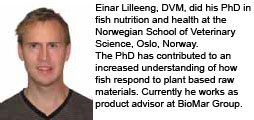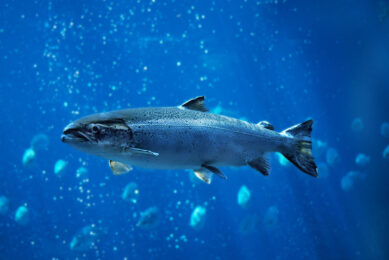Fish immune responses to soy feeding

Not much information is available on the interactions between plant feed ingredients and fish biology. To extend the knowledge on this topic, Einar Lilleeng dedicated his doctorate to studying the effects of soybean meal on the health and immune defence system of fish. His work involved some short and long term studies to investigate both acute and more chronic reactions in the intestines after feeding soy.
Already in 1989, soy was proposed as a suitable alternative to fish meal for use as a protein source in diets for farmed fish. However, studies on the distal intestine of Atlantic salmon revealed morphological changes, characterised as enteritis, caused by dietary soybean meal. Dietary inclusion levels of soybean meal as low as 10% cause negative effects on the distal intestinal mucosa of Atlantic salmon. This is because soybeans, as well as other high protein plant seeds available for fish feeds, contain a variety of anti-nutritional factors and bioactive compounds which can be grouped into protease inhibitors, lectins, goitrogens, antivitamins, saponins, tannins, estrogens, oligosaccharides, antigens, phytate and unknown factors. The distal intestine of salmonids is immunologically sensitive to one or more of these constituents, which can lead to a disturbed digestive process and a reduced health status. Recent studies indicate that these adverse effects in the distal intestine may be caused by a combination of several bioactive components found in plant material such as soy.
Soybean-enteritis
Another well known negative effect exerted by bioactive compounds in soybean meal, possible soybean trypsin inhibitors, is reduced activity of the enzyme protease trypsin in contents of the proximal intestine and elevated levels of trypsin in contents of the distal intestine in Atlantic salmon. Lilleeng showed an increased activity of protease trypsin in the intestines of salmon that suffered from the disease soybean-enteritis. Previously, most studies have been occupied studying chronic stages of this disease. In the present work both short term and long term trials were performed to specifically study inflammatory mechanisms at play during the induction of the enteritis and to further study the impact of dietary inclusion of SBM exhibiting high levels of soybean meal trypsin inhibitors.
Poor digestion of starch
Another part of the study looked at the effect of starch in salmon diets. The nutritive value of starch is limited, since salmon digest the starch very poorly.
Still, salmon diets contain 8-11% starch. The only pancreatic enzyme, to our knowledge, engaged in the digestion of starch is amylase and activity of amylase has not been demonstrated in the intestinal contents of Atlantic salmon using starch as substrate.
Although poorly digested in carnivorous fish, starch is a common compound in feed for fish and the low digestibility both represents a loss of energy for the fish and release of organic material to the environment. The present work aimed to find if the structure of the amylase gene could indicate the reason for low starch digestibility in Atlantic salmon.
Results and discussion
In Atlantic salmon fed soybean meal for 28 days pancreatic transcription of trypsinogen I and II, the two major isoforms in Atlantic salmon, were not altered by lowered activity of trypsin in proximal segments of the intestine. That indicates that regulation of digestive protease synthesis by diet in the pancreas of Atlantic salmon may be exerted at other levels than the transcriptional level. In support, an earlier study demonstrated that Atlantic salmon are able to augment the translation of trypsinogen following a continuous reduction in intestinal trypsin activity. A fine tuned regulation of pancreatic enzyme synthesis to meet changes in dietary composition of main nutrients (proteins, fat and carbohydrates) may not be necessary under natural conditions. Translational regulation of trypsinogen synthesis may therefore be sufficient to meet the demand for new enzyme in the pancreas to be ready for the next meal.
The adaptation to a diet high in protein and low in carbohydrate may have led to the survival of a dysfunctional amylase in Atlantic salmon. As starch is not present in the diet of wild Atlantic salmon, the need for a well functioning starch degrading enzyme is not crucial for survival. Mutations in the gene sequence for α-amylase limiting synthesis, secretion or substrate binding may therefore not be removed by natural selection. Comparison of the amino acid sequence with other species revealed a seven amino acid deletion in one of the large loops of the enzyme in relatively close proximity to the active site and a less hydrophobic signal peptide. These findings indicate impaired substrate binding and import into endoplasmatic reticulum during protein synthesis.
Trypsin activity
In a long term trial (13 weeks), trypsin activity in both contents and tissues of the distal intestine was investigated. The activity in salmon displaying soybean enteritis was elevated in the intestinal wall as well as in the intestinal contents. Similar reactions have also been described in rainbow trout, humans and in experimental models of colitis in animals. Increased activity of trypsin as a response to pathological changes in the intestine thus seems to be conserved between lower and higher vertebrates. The physiological function of trypsin in the intestine of Atlantic salmon may be related to the activation of proteinase activated receptor 2 (PAR-2). In mice, PAR-2 is highly expressed in the intestinal epithelium, and luminal trypsin activity has been demonstrated to activate PAR-2 in the intestine, thereby disrupting the intestinal barrier and inducing inflammation. To study the possible involvement of PAR-2 in Atlantic salmon with soybean meal-induced enteritis the full-length sequence(s) of PAR-2 was cloned.
Two transcript versions of PAR-2 in Atlantic salmon were found, which were termed PAR-2a and PAR-2b. The expression of PAR-2a and PAR-2b was studied in Atlantic salmon exposed to SBM for 0, 1, 3, 7 and 21 days by means of qPCR. We found that PAR-2a was up-regulated after 1 day and PAR-2b was up-regulated after 21 days of exposure to SBM.
The acute response in PAR-2a expression observed on day 1 may indicate a potential function in the induction of the SBM enteropathy, possibly by increasing the intestinal permeability and activating adaptive elements of the immune system. The late onset of PAR-2b expression suggests that the two versions of PAR-2 in Atlantic salmon have different roles in the SBM enteropathy.
Gene expression
Another gene responding rapidly to dietary inclusion of SBM in Atlantic salmon is TGF-β. TGF-βis a multi-functional growth factor important in control of normal epithelial cell proliferation and differentiation.
At the same time TGF-βhas been shown to be essential to mucosal immunity, by reducing the disruptive effect of cytokines and oral antigens on the epithelial barrier in mammals. After 1 day of soybean meal feeding TGF-βwas down-regulated and the expression stayed low throughout the experimental period of 7 days.
Similar findings of reduced levels of TGF-βhave been reported in a range of intestinal food allergies in children. Furthermore, defective TGF-βsignalling has been described in ulcerative colitis, Crohn disease and other forms of chronic inflammatory bowel diseases in man. The prompt and lasting down-regulation of TGF-βin the DI of Atlantic salmon fed SBM in the present thesis makes TGF-βa promising marker for the identification of SBM diets inducing inflammatory responses.
Conclusion
Decreased activity of trypsin in the proximal segments of the intestine in Atlantic salmon fed soybean meal was not reflected in altered transcription of trypsinogen in the pancreas. Comparison of the amino acid sequence of Atlantic salmon amylase with other species revealed a seven amino acid deletion in one of the large loops of the enzyme in relatively close proximity to the active site and a less hydrophobic signal peptide.
These findings indicate impaired substrate binding and import into ER (endoplasmatic reticulum) during protein synthesis. Many of the basic mechanisms observed in intestinal enteropathies are shared between lower and higher vertebrates, as indicated by our studies of the soybean meal enteropathy in Atlantic salmon.
Among these basic mechanisms are key responses like elevated intestinal protease activity, increased permeability (possibly due to increased PAR-2 expression) and decreased TGF-βsignalling.
The Aquaculture Protein Centre |
Join 26,000+ subscribers
Subscribe to our newsletter to stay updated about all the need-to-know content in the feed sector, three times a week. Beheer
Beheer









 WP Admin
WP Admin  Bewerk bericht
Bewerk bericht